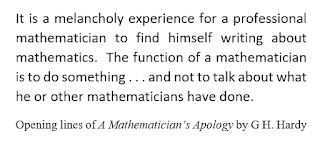Poet Robin Chapman and Julien Clinton Sprott both were professors at the University of Wisconsin-Madison when their art-poetry collection Images of a Complex World -- The Art and Poetry of Chaos first appeared (World Scientific Publishing, 2005) -- and now both are emeritus professors: Chapman in the Department of Communication Studies and Disorders and Sprott in the Department of Physics.
Here is one of the poems from that collection:
Bifurcations by Robin Chapman
This is the path that pitchforks
in the yellow wood -- the one
where you wanted to travel both,
science and poetry,
physics and art,
and so bounced unpredictably back and forth,
taking each as far as you could.
Notes: The pitchforking path in the opening lines draws my thoughts to Robert Frost's poem, "The Road Not Taken." A bifurcation is, in general, a division of a structure into two parts.
But when it happens over and over, things might change from patterned to
chaotic . . . Here is a link to earlier postings in this blog on fractals and chaos; here is a link to previous postings of poems by Robin Chapman. This link leads to discussion of "bifurcation" at WolframMathWorld. On page 82 of the art-poetry collection by Chapman and Sprott is this comment about the term: There are dozens of different types of bifurcations, and they represent an active area of current research. Below (and appearing on page 83 of the collection) is the following illustration:

In the preface to Images of a Complex World -- The Art and Poetry of Chaos, Sprott describes his process of choosing mathematical patterns and colors that would appeal to the human eye and Chapman offers insight into the inspirations for her poems.







